Transport and Response Coefficients in Second-Order Dissipative Relativistic Hydrodynamics with Quantum Corrections: Probing the Quark–Gluon Plasma
Abstract
1. Introduction
2. Functional Measure in AdS/CFT
3. Response and Transport Coefficients and Quantum Corrections Due to the Functional Measure
3.1. Perfect Fluid Flows in Hydrodynamics
3.2. Viscous Fluid Flows
4. Second-Order Derivative Expansion of Relativistic Hydrodynamics
5. Bounding the Parameter from Experimental Data from LHC and RHIC
6. Discussion
Author Contributions
Funding
Institutional Review Board Statement
Data Availability Statement
Conflicts of Interest
References
- Maldacena, J.M. The Large N Limit of Superconformal Field Theories and Supergravity. Adv. Theor. Math. Phys. 1998, 2, 231–252. [Google Scholar] [CrossRef]
- Gubser, S.S.; Klebanov, I.R.; Polyakov, A.M. Gauge theory correlators from non-critical string theory. Phys. Lett. B 1998, 428, 105–114. [Google Scholar] [CrossRef]
- Witten, E. Anti de Sitter Space and Holography. Adv. Theor. Math. Phys. 1998, 2, 253–291. [Google Scholar] [CrossRef]
- Nastase, H. Introduction to the AdS/CFT Correspondence; Cambridge University Press: Cambridge, UK, 2015. [Google Scholar]
- Iqbal, N.; Liu, H. Universality of the hydrodynamic limit in AdS/CFT and the membrane paradigm. Phys. Rev. D 2009, 79, 025023. [Google Scholar] [CrossRef]
- Son, D.T.; Starinets, A.O. Viscosity, Black Holes, and Quantum Field Theory. Ann. Rev. Nucl. Part. Sci. 2007, 57, 95. [Google Scholar] [CrossRef]
- Bhattacharyya, S.; Hubeny, V.E.; Minwalla, S.; Rangamani, M. Nonlinear Fluid Dynamics from Gravity. J. High Energy Phys. 2008, 2, 45. [Google Scholar] [CrossRef]
- Haack, M.; Yarom, A. Nonlinear viscous hydrodynamics in various dimensions using AdS/CFT. J. High Energy Phys. 2008, 10, 63. [Google Scholar] [CrossRef]
- Policastro, G.; Son, D.T.; Starinets, A.O. From AdS / CFT correspondence to hydrodynamics. J. High Energy Phys. 2002, 9, 43. [Google Scholar] [CrossRef]
- Bernardo, H.; Nastase, H. Holographic cosmology from “dimensional reduction” of = 4 SYM vs. AdS5×S5. J. High Energy Phys. 2019, 12, 25. [Google Scholar] [CrossRef]
- Bemfica, F.S.; Disconzi, M.M.; Noronha, J. Causality and existence of solutions of relativistic viscous fluid dynamics with gravity. Phys. Rev. D 2018, 98, 104064. [Google Scholar] [CrossRef]
- Rocha, G.S.; Denicol, G.S.; Noronha, J. Perturbative approaches in relativistic kinetic theory and the emergence of 1ST-order hydrodynamics. Phys. Rev. D 2022, 106, 036010. [Google Scholar] [CrossRef]
- Kovtun, P. 1ST-order relativistic hydrodynamics is stable. J. High Energy Phys. 2019, 10, 34. [Google Scholar]
- Hoult, R.E.; Kovtun, P. Stable and causal relativistic Navier-Stokes equations. J. High Energy Phys. 2020, 6, 67. [Google Scholar] [CrossRef]
- Policastro, G.; Son, D.T.; Starinets, A.O. The Shear viscosity of strongly coupled N = 4 supersymmetric Yang-Mills plasma. Phys. Rev. Lett. 2001, 87, 081601. [Google Scholar] [CrossRef]
- Ferreira-Martins, A.J.; da Rocha, R. Generalized Navier–Stokes equations and soft hairy horizons in fluid/gravity correspondence. Nucl. Phys. B 2021, 973, 115603. [Google Scholar] [CrossRef]
- Ferreira–Martins, A.J.; Meert, P.; da Rocha, R. AdS5-Schwarzschild deformed black branes and hydrodynamic transport coefficients. Nucl. Phys. B 2020, 957, 115087. [Google Scholar] [CrossRef]
- Meert, P.; da Rocha, R. The emergence of flagpole and flag-dipole fermions in fluid/gravity correspondence. Eur. Phys. J. C 2018, 78, 1012. [Google Scholar] [CrossRef]
- Bonora, L.; de Brito, K.P.S.; da Rocha, R. Spinor Fields Classification in Arbitrary Dimensions and New Classes of Spinor Fields on 7-Manifolds. J. High Energy Phys. 2015, 2, 69. [Google Scholar] [CrossRef]
- de Souza, R.D.; Koide, T.; Kodama, T. Hydrodynamic Approaches in Relativistic Heavy Ion Reactions. Prog. Part. Nucl. Phys. 2016, 86, 35. [Google Scholar] [CrossRef]
- Karapetyan, G. The nuclear configurational entropy approach to dynamical QCD effects. Phys. Lett. B 2018, 786, 418. [Google Scholar] [CrossRef]
- Karapetyan, G. Configurational entropy and ρ and ϕ mesons production in QCD. Phys. Lett. B 2018, 781, 201. [Google Scholar] [CrossRef]
- Karapetyan, G. Configurational entropy and the N∗(1440) Roper resonance in QCD. Ann. Phys. 2024, 462, 169612. [Google Scholar] [CrossRef]
- Peralta-Ramos, J.; Krein, G. Dissipative hydrodynamics coupled to chiral fields. Phys. Rev. C 2011, 84, 044904. [Google Scholar] [CrossRef]
- Gubser, S.S.; Nellore, A.; Pufu, S.S.; Rocha, F.D. Thermodynamics and bulk viscosity of approximate black hole duals to finite temperature quantum chromodynamics. Phys. Rev. Lett. 2008, 101, 131601. [Google Scholar] [CrossRef]
- Critelli, R.; Finazzo, S.I.; Zaniboni, M.; Noronha, J. Anisotropic shear viscosity of a strongly coupled non-Abelian plasma from magnetic branes. Phys. Rev. D 2014, 90, 066006. [Google Scholar] [CrossRef]
- Ayala, A.; Mizher, A.J. Influence of magnetic field-induced anisotropic gluon pressure during pre-equilibrium in heavy-ion collisions: A faster road toward isotropization. Phys. Rev. D 2024, 110, L111501. [Google Scholar] [CrossRef]
- Finazzo, S.I.; Critelli, R.; Rougemont, R.; Noronha, J. Momentum transport in strongly coupled anisotropic plasmas in the presence of strong magnetic fields. Phys. Rev. D 2016, 94, 054020, Erratum in Phys. Rev. D 2017, 96, 019903. [Google Scholar] [CrossRef]
- Jena, S.S.; Barman, J.; Toniato, B.; Dudal, D.; Mahapatra, S. A dynamical Einstein-Born-Infeld-dilaton model and holographic quarkonium melting in a magnetic field. J. High Energy Phys. 2024, 12, 096. [Google Scholar] [CrossRef]
- Jena, S.S.; Shukla, B.; Dudal, D.; Mahapatra, S. Entropic force and real-time dynamics of holographic quarkonium in a magnetic field. Phys. Rev. D 2022, 105, 086011. [Google Scholar] [CrossRef]
- Ballon-Bayona, A.; Mamani, L.A.H.; Miranda, A.S.; Zanchin, V.T. Effective holographic models for QCD: Thermodynamics and viscosity coefficients. Phys. Rev. D 2021, 104, 046013. [Google Scholar] [CrossRef]
- Hippert, M.; Grefa, J.; Manning, T.A.; Noronha, J.; Noronha-Hostler, J.; Vazquez, I.P.; Ratti, C.; Rougemont, R.; Trujillo, M. Bayesian location of the QCD critical point from a holographic perspective. Phys. Rev. D 2024, 110, 094006. [Google Scholar] [CrossRef]
- Mamani, L.A.H.; Hou, D.; Braga, N.R.F. Melting of heavy vector mesons and quasinormal modes in a finite density plasma from holography. Phys. Rev. D 2022, 105, 126020. [Google Scholar] [CrossRef]
- Shen, C.; Schenke, B.; Zhao, W. Viscosities of the Baryon-Rich Quark-Gluon Plasma from Beam Energy Scan Data. Phys. Rev. Lett. 2024, 132, 072301. [Google Scholar] [CrossRef] [PubMed]
- Gardim, F.G.; Krupczak, R.; da Silva, T.N. Smallest drop of QGP: Thermodynamic properties of p-Pb collisions. Phys. Rev. C 2024, 109, 014904. [Google Scholar] [CrossRef]
- Czajka, A.; Jeon, S. Kubo formulas for the shear and bulk viscosity relaxation times and the scalar field theory shear τπ calculation. Phys. Rev. C 2017, 95, 064906. [Google Scholar] [CrossRef]
- Denicol, G.S.; Noronha, J.; Niemi, H.; Rischke, D.H. Origin of the Relaxation Time in Dissipative Fluid Dynamics. Phys. Rev. D 2011, 83, 074019. [Google Scholar] [CrossRef]
- Koide, T.; Nakano, E.; Kodama, T. Shear viscosity coefficient and relaxation time of causal dissipative hydrodynamics in QCD. Phys. Rev. Lett. 2009, 103, 052301. [Google Scholar] [CrossRef]
- Baier, R.; Romatschke, P.; Son, D.T.; Starinets, A.O.; Stephanov, M.A. Relativistic viscous hydrodynamics, conformal invariance, and holography. J. High Energy Phys. 2008, 04, 100. [Google Scholar] [CrossRef]
- Moore, G.D.; Sohrabi, K.A. Kubo Formulae for 2nd-Order Hydrodynamic Coefficients. Phys. Rev. Lett. 2011, 106, 122302. [Google Scholar] [CrossRef]
- Hong, J.; Teaney, D. Spectral densities for hot QCD plasmas in a leading log approximation. Phys. Rev. C 2010, 82, 044908. [Google Scholar] [CrossRef]
- Kuntz, I.; da Rocha, R. Transport coefficients in AdS/CFT and quantum gravity corrections due to a functional measure. Nucl. Phys. B 2023, 993, 116258. [Google Scholar] [CrossRef]
- Vilkovisky, G.A. The Unique Effective Action in Quantum Field Theory. Nucl. Phys. B 1984, 234, 125. [Google Scholar] [CrossRef]
- Mottola, E. Functional integration over geometries. J. Math. Phys. 1995, 36, 2470. [Google Scholar] [CrossRef]
- Fujikawa, K. Path Integral Measure for Gravitational Interactions. Nucl. Phys. B 1983, 226, 437. [Google Scholar] [CrossRef]
- Fujikawa, K. Path Integral Measure for Gauge Invariant Fermion Theories. Phys. Rev. Lett. 1979, 42, 1195. [Google Scholar] [CrossRef]
- Toms, D.J. The Functional Measure for Quantum Field Theory in Curved Space-time. Phys. Rev. D 1987, 35, 3796. [Google Scholar] [CrossRef]
- DeWitt, B.S. The Global Approach to Quantum Field Theory; Oxford University Press: Oxford, UK, 2003. [Google Scholar]
- Everett, D.; Ke, W.; Paquet, J.-F.; Vujanovic, G.; Bass, S.A.; Du, L.; Gale, C.; Heffernan, M.; Heinz, U.; JETSCAPE Collaboration. Phenomenological constraints on the transport properties of QCD matter with data-driven model averaging. Phys. Rev. Lett. 2021, 126, 242301. [Google Scholar] [CrossRef]
- Everett, D.; Oliinychenko, D.; Luzum, M.; Paquet, J.-F.; Vujanovic, G.; Bass, S.A.; Du, L.; Gale, C.; Heffernan, M.; JETSCAPE Collaboration. Role of bulk viscosity in deuteron production in ultrarelativistic nuclear collisions. Phys. Rev. C 2022, 106, 064901. [Google Scholar] [CrossRef]
- Bernhard, J.E.; Moreland, J.S.; Bass, S.A. Bayesian estimation of the specific shear and bulk viscosity of quark–gluon plasma. Nat. Phys. 2019, 15, 1113. [Google Scholar] [CrossRef]
- Parkkila, J.E.; Onnerstad, A.; Taghavi, S.F.; Mordasini, C.; Bilandzic, A.; Virta, M.; Kim, D.J. New constraints for QCD matter from improved Bayesian parameter estimation in heavy-ion collisions at LHC. Phys. Lett. B 2022, 835, 137485. [Google Scholar] [CrossRef]
- Nijs, G.; Schee, W.v.; Gürsoy, U.; Snellings, R. Bayesian analysis of heavy ion collisions with the heavy ion computational framework Trajectum. Phys. Rev. C 2021, 103, 054909. [Google Scholar] [CrossRef]
- Nijs, G.; Schee, W.v. Hadronic Nucleus-Nucleus Cross Section and the Nucleon Size. Phys. Rev. Lett. 2022, 129, 232301. [Google Scholar] [CrossRef] [PubMed]
- Yang, Z.; Chen, L.W. Bayesian inference of the specific shear and bulk viscosities of the quark-gluon plasma at crossover from ϕ and Ω observables. Phys. Rev. C 2023, 107, 064910. [Google Scholar] [CrossRef]
- Kuntz, I.; Casadio, R.; Kamenshchik, A. Covariant singularities: A brief review. Mod. Phys. Lett. A 2022, 37, 2230007. [Google Scholar] [CrossRef]
- Natsuume, M. AdS/CFT Duality User Guide; Lecture Notes in Physics; Springer: Tokyo, Japan, 2015; Volume 903. [Google Scholar]
- Gubser, S.S.; Pufu, S.S.; Rocha, F.D. Bulk viscosity of strongly coupled plasmas with holographic duals. J. High Energy Phys. 2008, 8, 085. [Google Scholar] [CrossRef]
- Buchel, A. Bulk viscosity of gauge theory plasma at strong coupling. Phys. Lett. B 2008, 663, 286. [Google Scholar] [CrossRef]
- Kovtun, P.; Son, D.T.; Starinets, A.O. Viscosity in strongly interacting quantum field theories from black hole physics. Phys. Rev. Lett. 2005, 94, 111601. [Google Scholar] [CrossRef]
- Arnold, P.; Vaman, D.; Wu, C.; Xiao, W. Second order hydrodynamic coefficients from 3-point energy-momentum tensor correlators via AdS/CFT. J. High Energy Phys. 2011, 10, 033. [Google Scholar]
- Kovtun, P.; Moore, G.D.; Romatschke, P. The stickiness of sound: An absolute lower limit on viscosity and the breakdown of second order relativistic hydrodynamics. Phys. Rev. D 2011, 84, 025006. [Google Scholar] [CrossRef]
- Finazzo, S.I.; Rougemont, R.; Marrochio, H.; Noronha, J. Hydrodynamic transport coefficients for the non-conformal quark-gluon plasma from holography. J. High Energy Phys. 2015, 02, 51. [Google Scholar] [CrossRef]
- Buchel, A.; Heller, M.P.; Noronha, J. Entropy Production, Hydrodynamics, and Resurgence in the Primordial Quark-Gluon Plasma from Holography. Phys. Rev. D 2016, 94, 106011. [Google Scholar] [CrossRef]
- Schenke, B.; Tribedy, P.; Venugopalan, R. Fluctuating Glasma initial conditions and flow in heavy ion collisions. Phys. Rev. Lett. 2012, 108, 252301. [Google Scholar] [CrossRef] [PubMed]
- da Rocha, R. Deformations of the AdS–Schwarzschild black brane and the shear viscosity of the quark–gluon plasma. Eur. Phys. J. Plus 2024, 139, 1006. [Google Scholar] [CrossRef]
- Rougemont, R.; Grefa, J.; Hippert, M.; Noronha, J.; Noronha-Hostler, J.; Portillo, I.; Ratti, C. Hot QCD phase diagram from holographic Einstein–Maxwell–Dilaton models. Prog. Part. Nucl. Phys. 2024, 135, 104093. [Google Scholar] [CrossRef]
- Braga, N.R.F.; Junqueira, O.C. Inhomogeneity of a rotating quark-gluon plasma from holography. Phys. Lett. B 2024, 848, 138330. [Google Scholar] [CrossRef]
- Oliveira, O.; Frederico, T.; de Paula, W. The soft-gluon limit and the infrared enhancement of the quark-gluon vertex. Eur. Phys. J. C 2020, 80, 484. [Google Scholar] [CrossRef]
- Braga, N.R.F.; Faulhaber, L.F.; Junqueira, O.C. Confinement-deconfinement temperature for a rotating quark-gluon plasma. Phys. Rev. D 2022, 105, 106003. [Google Scholar] [CrossRef]
- Romatschke, P. Relativistic Viscous Fluid Dynamics and Non-Equilibrium Entropy. Class. Quant. Grav. 2010, 27, 025006. [Google Scholar] [CrossRef]
- Natsuume, M.; Okamura, T. Causal hydrodynamics of gauge theory plasmas from AdS/CFT duality. Phys. Rev. D 2008, 77, 066014, Erratum in Phys. Rev. D 2008, 78, 089902. [Google Scholar] [CrossRef]
- Rocha, G.S.; Ferreira, M.N.; Denicol, G.S.; Noronha, J. Transport coefficients of quasiparticle models within a new relaxation time approximation of the Boltzmann equation. Phys. Rev. D 2022, 106, 036022. [Google Scholar] [CrossRef]
- Rocha, G.S.; Denicol, G.S.; Noronha, J. Novel Relaxation Time Approximation to the Relativistic Boltzmann Equation. Phys. Rev. Lett. 2021, 127, 042301. [Google Scholar] [CrossRef] [PubMed]
- Buchel, A. Gravitational susceptibility of QGP. Phys. Rev. D 2022, 106, 126024. [Google Scholar] [CrossRef]
- Wang, E.; Heinz, U.W. A Generalized fluctuation dissipation theorem for nonlinear response functions. Phys. Rev. D 2002, 66, 025008. [Google Scholar] [CrossRef]
- Chou, K.c.; Su, Z.b.; Hao, B.l.; Yu, L. Equilibrium and Nonequilibrium Formalisms Made Unified. Phys. Rep. 1985, 118, 1–131. [Google Scholar] [CrossRef]
- Borsanyi, S.; Endrodi, G.; Fodor, Z.; Katz, S.D.; Krieg, S.; Ratti, C.; Szabo, K.K. QCD equation of state at nonzero chemical potential: Continuum results with physical quark masses at order μ2. J. High Energy Phys. 2012, 08, 053. [Google Scholar] [CrossRef]
- da Rocha, R. Holographic entanglement entropy, deformed black branes, and deconfinement in AdS/QCD. Phys. Rev. D 2022, 105, 026014. [Google Scholar] [CrossRef]
- Braga, N.R.F.; Junqueira, O.C. Hawking-Page transition in holographic QCD at finite density. Phys. Lett. B 2024, 855, 138813. [Google Scholar] [CrossRef]
- Gardim, F.G.; Ollitrault, J.Y. Effective shear and bulk viscosities for anisotropic flow. Phys. Rev. C 2021, 103, 044907. [Google Scholar] [CrossRef]
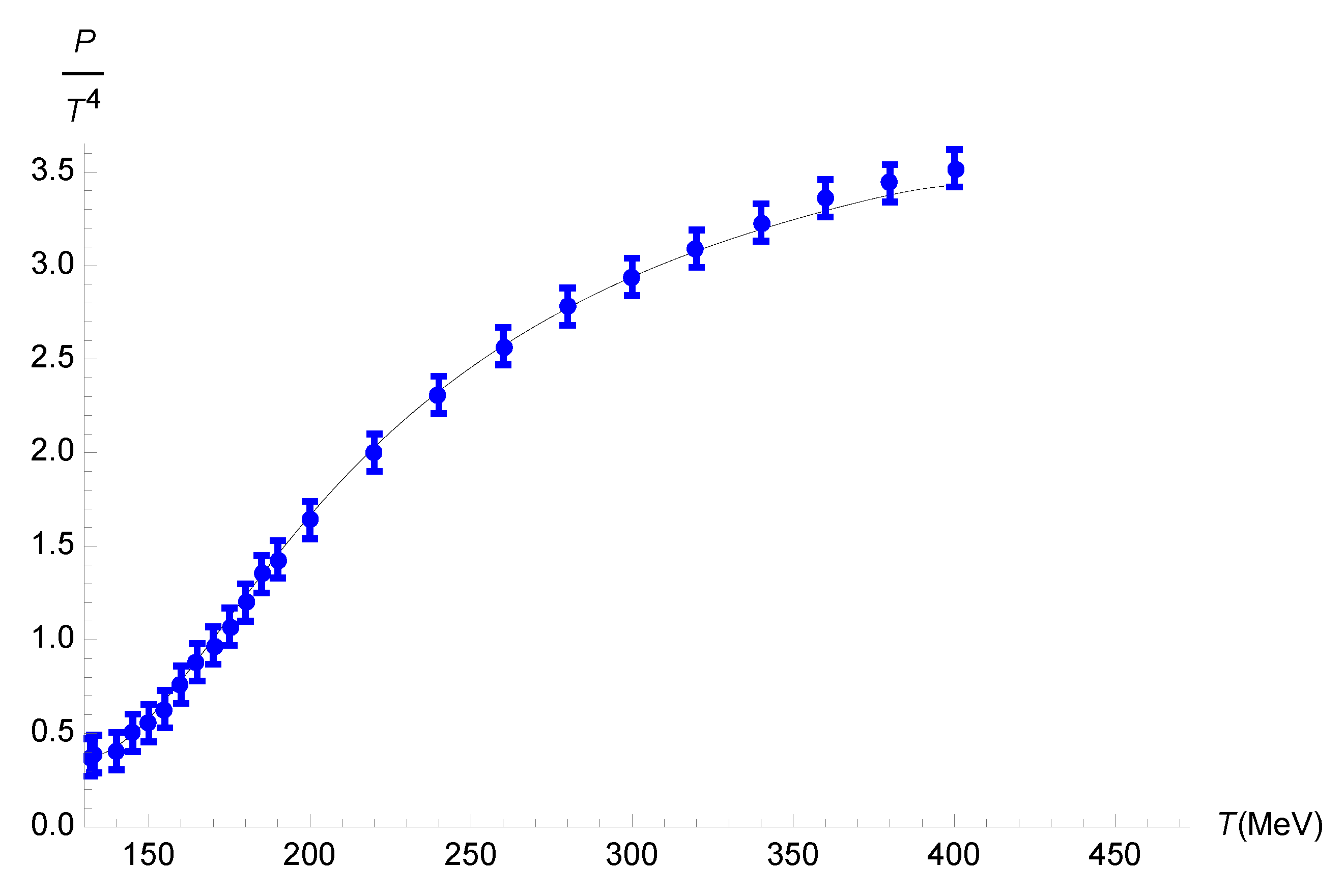
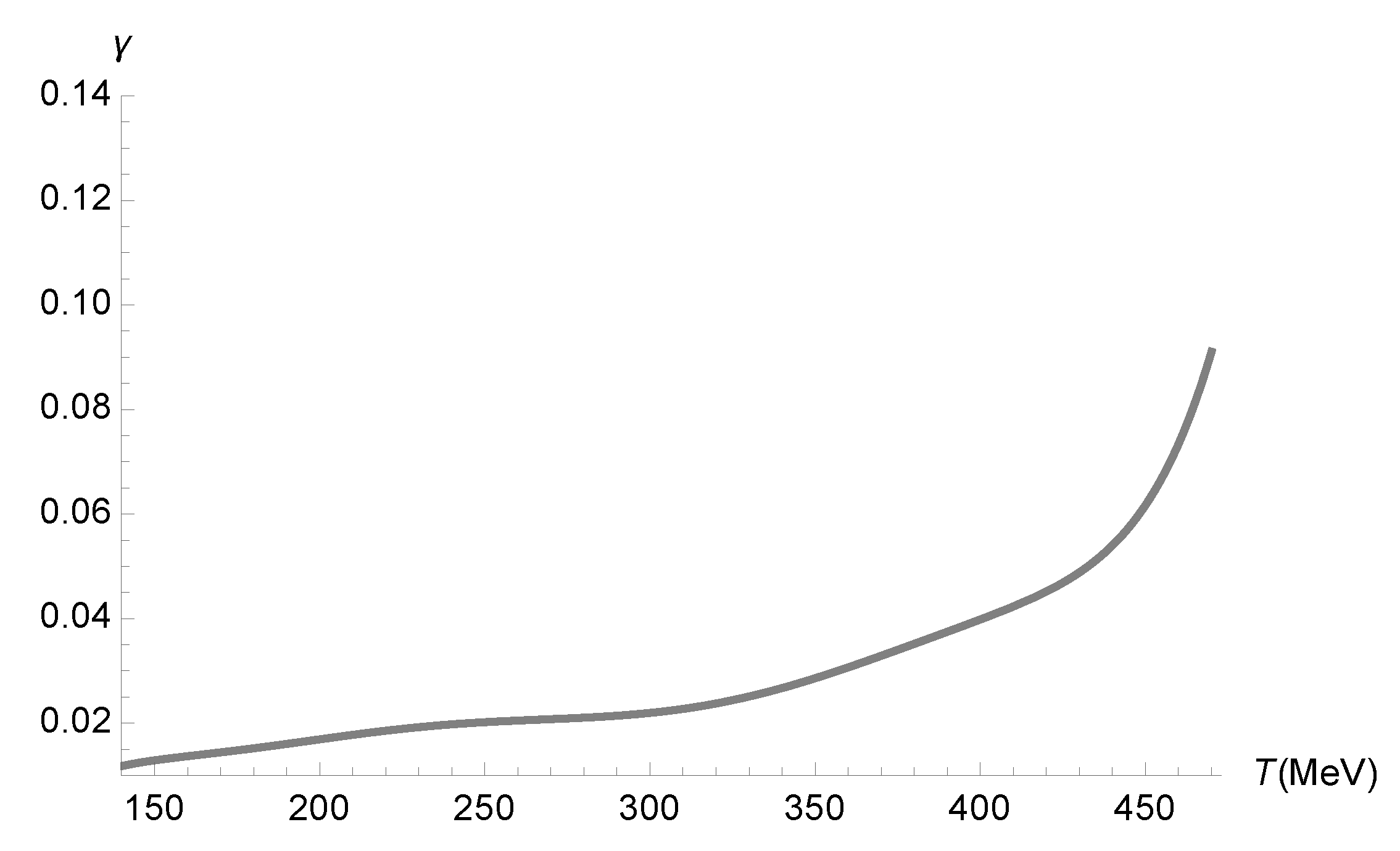
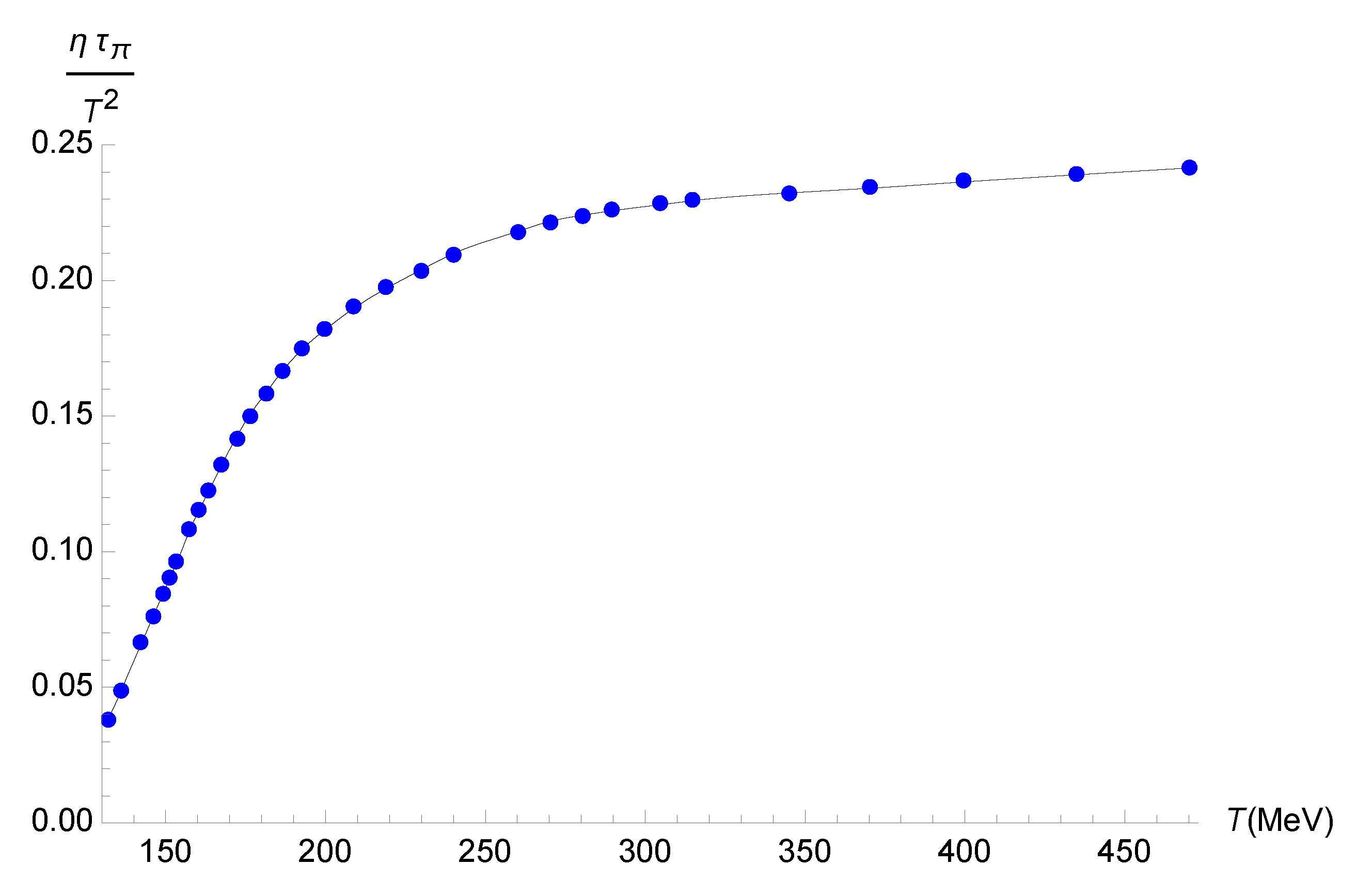
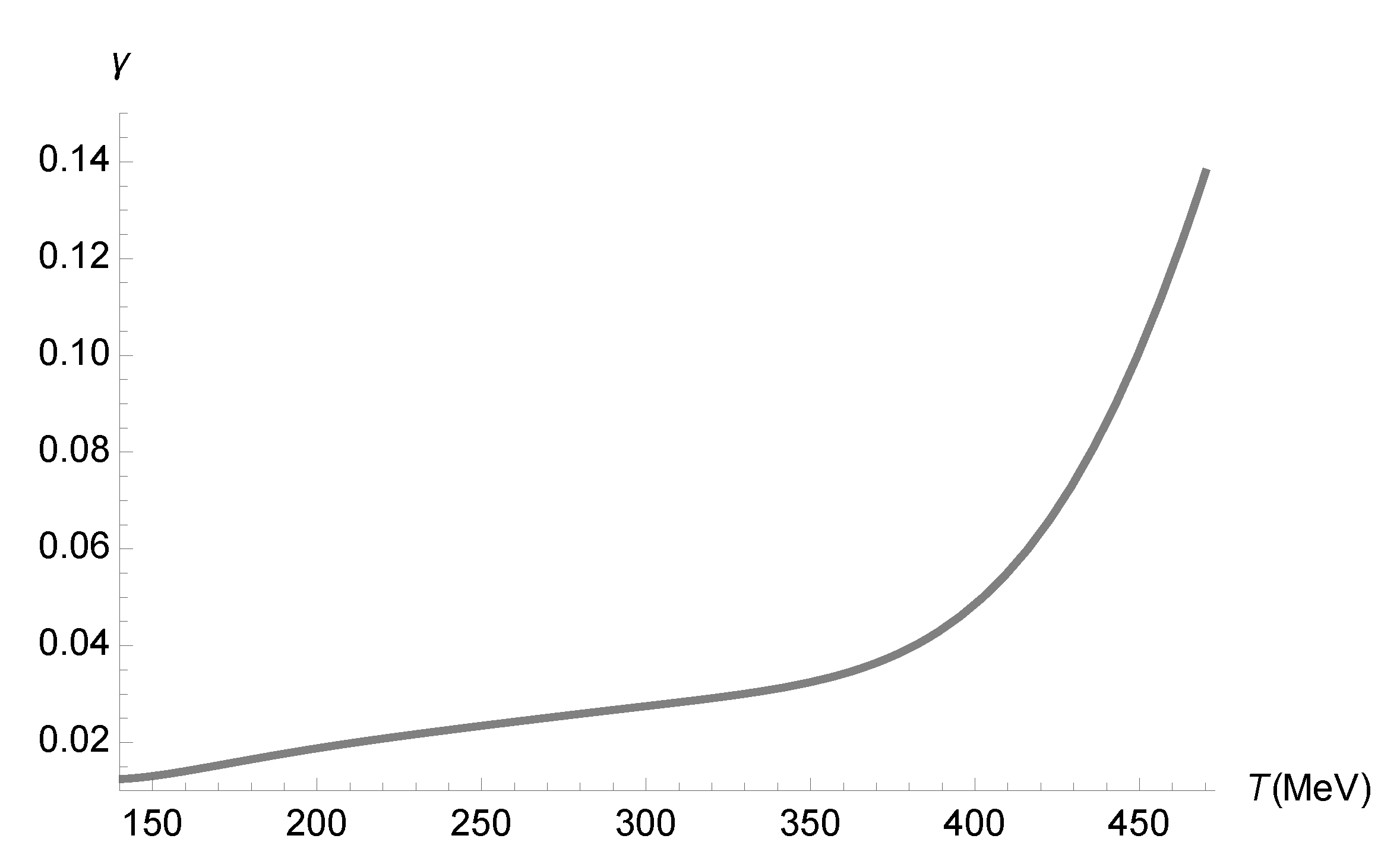
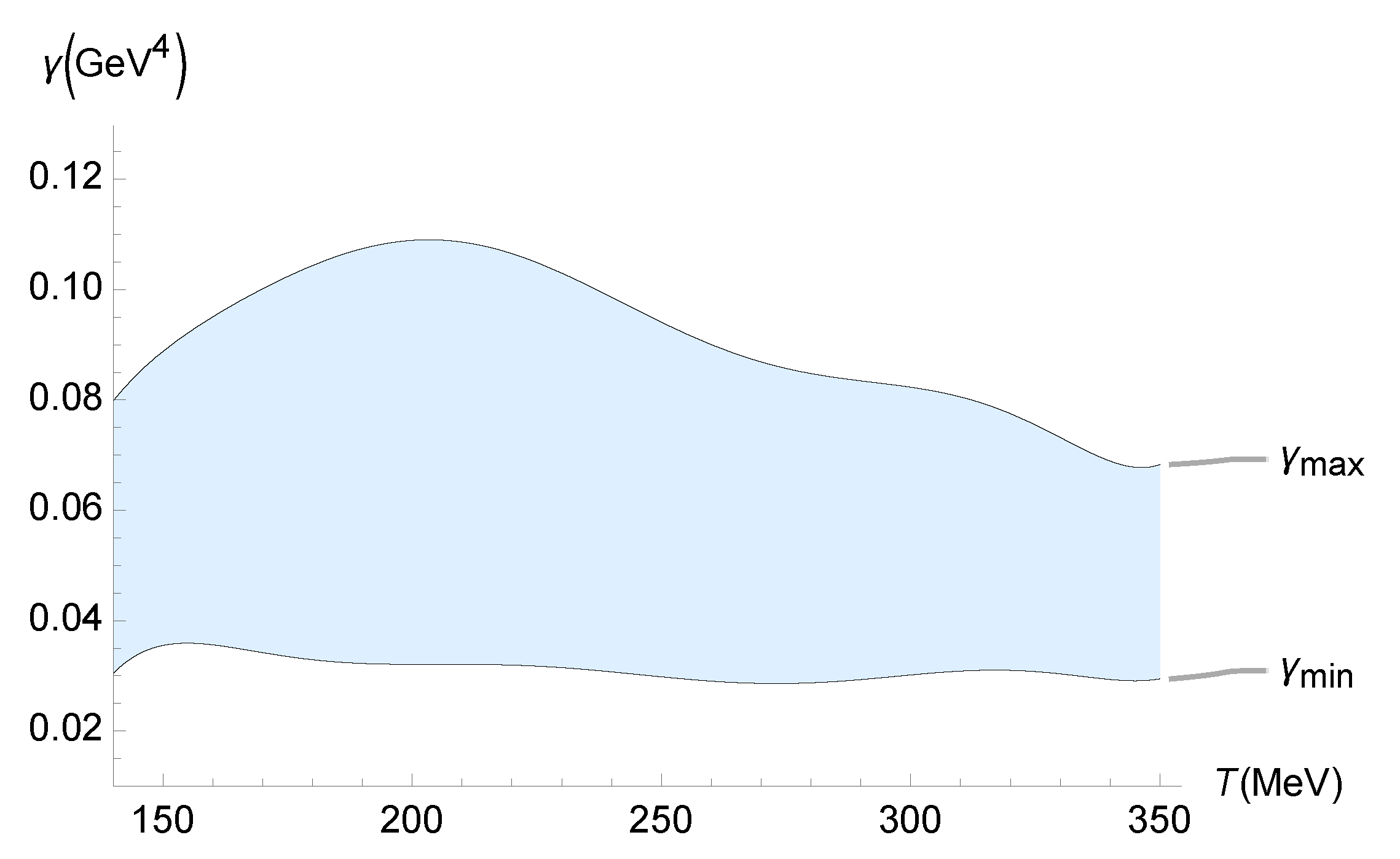
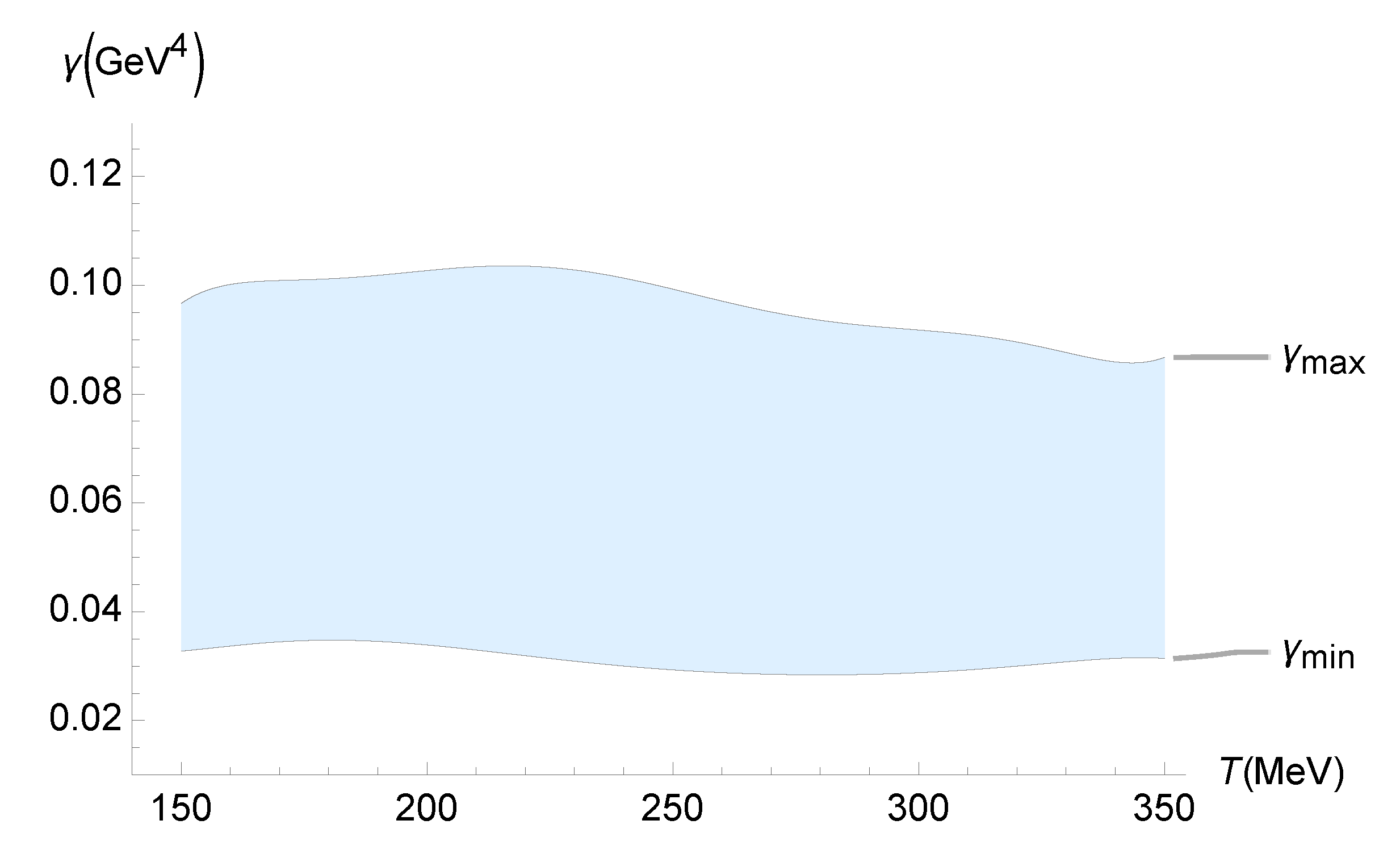
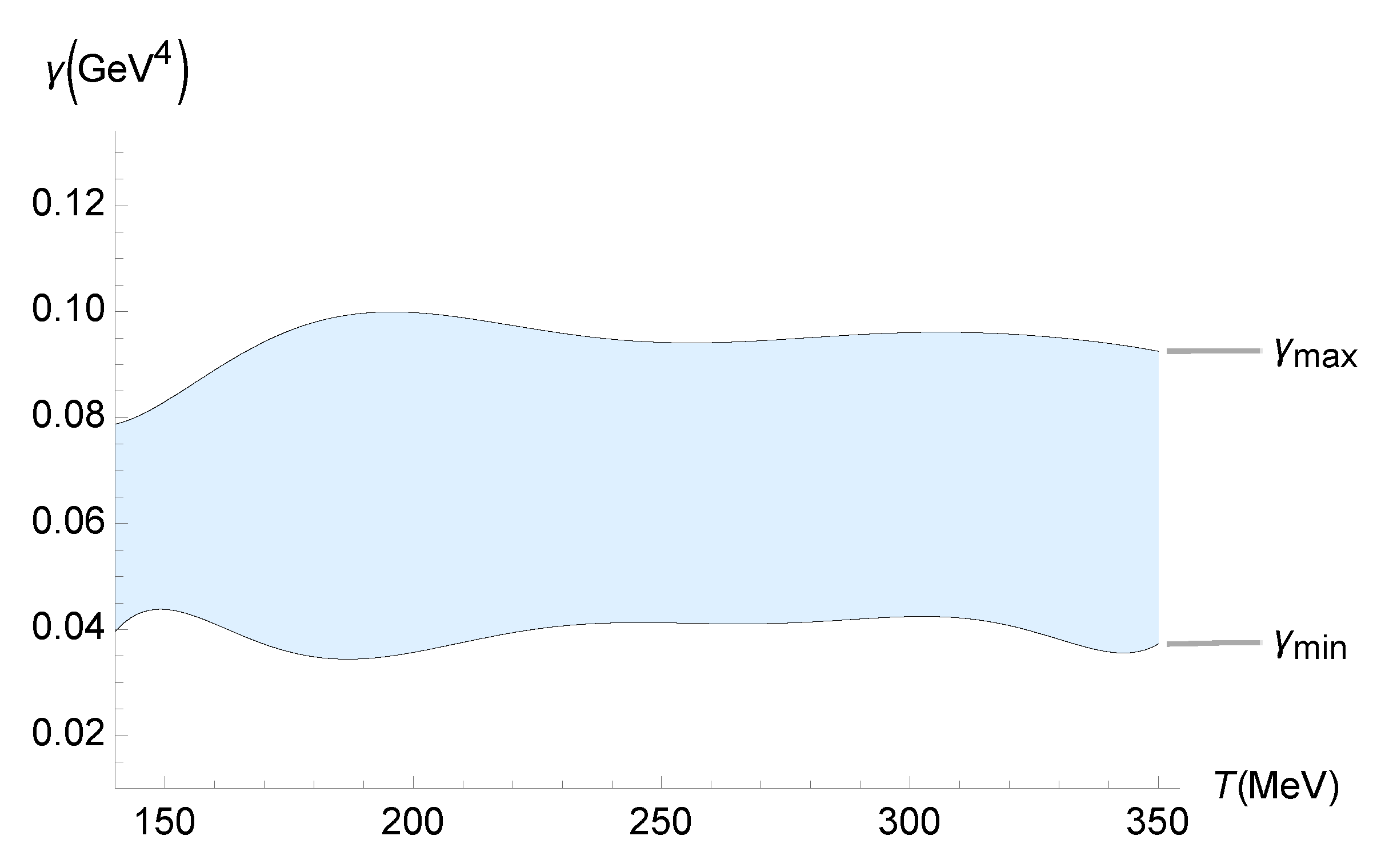



Disclaimer/Publisher’s Note: The statements, opinions and data contained in all publications are solely those of the individual author(s) and contributor(s) and not of MDPI and/or the editor(s). MDPI and/or the editor(s) disclaim responsibility for any injury to people or property resulting from any ideas, methods, instructions or products referred to in the content. |
© 2025 by the authors. Licensee MDPI, Basel, Switzerland. This article is an open access article distributed under the terms and conditions of the Creative Commons Attribution (CC BY) license (https://creativecommons.org/licenses/by/4.0/).
Share and Cite
Kuntz, I.; da Rocha, R. Transport and Response Coefficients in Second-Order Dissipative Relativistic Hydrodynamics with Quantum Corrections: Probing the Quark–Gluon Plasma. Entropy 2025, 27, 580. https://doi.org/10.3390/e27060580
Kuntz I, da Rocha R. Transport and Response Coefficients in Second-Order Dissipative Relativistic Hydrodynamics with Quantum Corrections: Probing the Quark–Gluon Plasma. Entropy. 2025; 27(6):580. https://doi.org/10.3390/e27060580
Chicago/Turabian StyleKuntz, Iberê, and Roldao da Rocha. 2025. "Transport and Response Coefficients in Second-Order Dissipative Relativistic Hydrodynamics with Quantum Corrections: Probing the Quark–Gluon Plasma" Entropy 27, no. 6: 580. https://doi.org/10.3390/e27060580
APA StyleKuntz, I., & da Rocha, R. (2025). Transport and Response Coefficients in Second-Order Dissipative Relativistic Hydrodynamics with Quantum Corrections: Probing the Quark–Gluon Plasma. Entropy, 27(6), 580. https://doi.org/10.3390/e27060580







